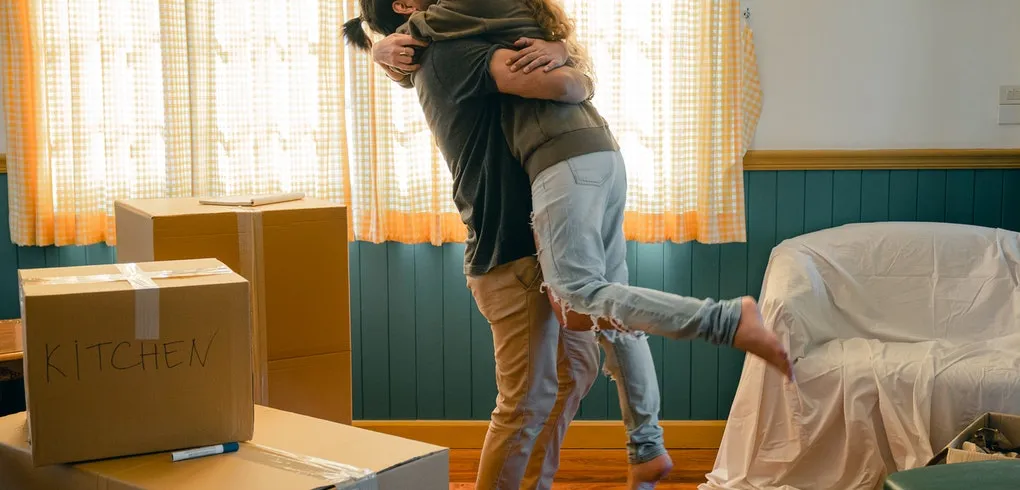
Part Buy, Part Rent and Shared Ownership
Here you’ll learn all about shared ownership – what it is, how it works, the different schemes available, the process of staircasing, the benefits, the drawbacks and more.
Did you know you can part buy, part rent a property through shared ownership? In this guide, we explain how shared ownership works so you can decide whether it would suit you.
We’ve all heard about how difficult it is to get on the property ladder, but there are actually a lot of options out there which can help. Shared ownership is a good one. It’s a useful way for people who can’t afford a mortgage on 100% of a property buy part of one. You can also work your way up to owning the whole property bit by bit, when you have the money.
Shared ownership isn’t only for first time buyers either. It’s a great way for people who used to own a property, but can’t afford to buy one now, climb back onto the property ladder. Existing shared owners can also use shared ownership schemes to move up the property ladder.
Our shared ownership guide covers everything from what shared ownership means and how it works to the costs you’ll need to think about, the different schemes available and more. That way, you can decide whether shared ownership is a good idea for you.
Contents
What Does Shared Ownership Mean?
Shared ownership is a system in the UK where you buy a percentage of a property, typically from a housing association or local authority, and pay rent on the remaining portion that you don’t own. You can secure a mortgage on the portion of the property you buy, if needed.
Shared ownership schemes in England, include:
- Help to Buy: Shared Ownership
- Older People’s Shared Ownership (OPSO)
- Individual schemes offered by local housing associations
- Social HomeBuy
We go through how each shared ownership scheme works a little later on in this guide.
An important thing to know about shared ownership is that it’s not the same as joint ownership. Joint ownership is a situation when 2 or more people buy a property together without the help of any external schemes or parties. If they’re buying a residence, then they’ll usually both live there. The way shared ownership works is completely different.
With shared ownership, you own your share of the property on a leasehold basis and a housing association owns the rest – unless you “staircase” to full ownership. We explain staircasing below.
You can purchase a shared ownership property with another person, i.e. you can jointly own a shared ownership property. In this case, you and your co-owner would own the share you purchase together and would both be liable to pay rent on the remaining share owned by the housing association.
How Does Shared Ownership Work?
Shared ownership can be explained as a big umbrella that encompasses multiple schemes. Every scheme is a little different and comes with its own criteria. However, the general premise remains the same:
You buy at least 25% of a property from a housing association – or sometimes a local authority if you’re buying a share of your council house through Social HomeBuy – and pay rent at a typically reduced rate on the remaining portion that you don’t own. Annual rent is usually set at about 3% of the unsold equity at the time of the initial purchase.
You’ll no longer pay rent once you fully “staircase” and purchase the final share amount so that you own 100% – or 75% if you use the Older Person’s Shared Ownership (OPSO) scheme. We go into that in more detail later.
To buy a percentage of a shared ownership property, you take out a mortgage for the value of the share you’re going to buy or you can fund the purchase through your savings. The mortgage products available to you will vary depending on the lender, so it’s best to use a broker who can identify what’s suitable. You’ll need to put down at least a 5% deposit to secure a mortgage, but that’s 5% of the share you’re purchasing, not the total value of the property.
Example
- You take out a mortgage to buy a 50% share of a £150,000 property
- Your share is worth £75,000 (£150,000 ÷ 2)
- You put down a 5% deposit on the mortgage
- 5% of £75,000 = £3,750
- You pay rent on the remaining £75,000 share
- 3% of £75,000 = £2,250
- You pay £2,250 yearly
- That’s £187.50 per month (£2,250 ÷ 12)
You can buy extra shares in your shared ownership property from your housing association or local authority at any time by a process called “staircasing”. The rent you pay should reduce as you buy more shares and your equity in the property increases.
Monthly costs
All shared ownership properties are leasehold. You don’t own the ground on which a leasehold property stands and you technically only own the property for a certain period, normally between 99 – 125 years. However, you can extend the lease term at a point in the future if you want to.
You’re also liable to pay certain costs on a leasehold property that you wouldn’t on a freehold.
For a shared ownership property, you’ll likely pay the following each month:
- Mortgage repayments – these will vary depending on the type of mortgage you took out and the overall term
- Rent on the remaining share of the property owned by the housing association
- Ground rent – this is payable on all leasehold properties and is a a relatively small amount of money
- A service charge – you pay a service charge to the housing association for maintenance and repairs to any common areas and grounds, building insurance and sometimes management costs
- Contents insurance – contents insurance is actually optional but we always recommend it
Sometimes, there is a provision in the lease for the leaseholder to purchase the freehold when they buy the remaining shares of the shared ownership property. This is called the final staircasing and we explain it in more detail below.
It’s also worth bearing in mind that you’ll have to cover certain costs when purchasing a property, like Stamp Duty, mortgage broker fees, conveyancing fees, etc. You can find out all you need to know about costs and fees in our First Time Buyer’s Guide.
Help to Buy: Shared Ownership
The Help to Buy: Shared Ownership scheme is funded by the government and available from many housing associations who are Registered Providers. Some housing associations will have their own shared ownership scheme with potentially different criteria.
In England, you can buy between 25% – 75% of a property from a housing association that offers Help to Buy: Shared Ownership. You pay rent at a reduced rate on the remaining share, usually about 3% of the total value of the unsold equity at the time of the initial purchase. Your rent may decrease as you buy a greater share in the property, but this depends on house market prices and is ultimately up to your landlord.
To opt into the scheme, you must meet the Help to Buy: Shared Ownership eligibility criteria.
Who’s eligible?
To be eligible for Help to Buy: Shared Ownership, you must:
- Be a first-time buyer or a previous homeowner who can’t afford to buy a property now
- Have a combined household income of less than £80,000, or £90,000 in London
If you work in the armed forces, you’ll be given priority over other buyers.
The rules and regulations of shared ownership are different for Northern Ireland and Scotland. You should also contact your local authority to find out about buying a shared ownership property in Wales.
You can apply for Help to Buy: Shared Ownership by contacting your local Help to Buy agent.
See our guide on Help to Buy for information about other government housing schemes.
Older Person’s Shared Ownership (OPSO)
The OPSO is also a government funded housing scheme. It’s specifically for retired people with low income. The main differences between OPSO and Help to Buy: Shared Ownership are:
- You can only own up to 75% of a property through an OPSO scheme
- You won’t pay any rent once you own the maximum of 75%
Who’s eligible?
To be eligible for OPSO, you must:
- Be aged 55 or over
- Have an annual household income of no more than £80,000
- Be unable to purchase a home suitable for your needs without assistance
- Sell any existing property before buying through OPSO, however you won’t require a Local Authority nomination to be approved as eligible
- Must not have any outstanding credit issues, e.g. unsatisfied defaults or county court judgments
Some OPSO developments offer Extra Care, which are schemes designed to enable residence to live independently in self-contained homes but with access to care and support services.
Social HomeBuy
Social HomeBuy is a scheme designed to help people buy a share of their council house, or sometimes to buy the property outright. If you’re buying on shared ownership terms, the initial share you purchase must be at least 25% and a maximum of 90%. Any further shares purchased through staircasing must be a minimum of 10%.
You’ll pay rent at a discounted market rate on the remaining share.
If you purchase through the Social HomeBuy scheme, you’re entitled to a discount on initial and subsequent shares. The discount you’ll receive will depend on the Right to Acquire discount for your area.
Example
- Your council house is worth £150,000
- The Right to Acquire discount for your area is: £16,000
- You purchase a 75% share of your property which would be worth: £112,500
- You then receive 75% of the Right to Acquire discount
- 75% of £16,000 = £12,000
- £12,000 is 8% of £150,000, so you receive an 8% discount of the property’s total market value
Who’s eligible?
To be eligible for Social HomeBuy:
- You must occupy a council house eligible for Social HomeBuy
- Your housing association or council must be a participant in the scheme
- You must have been the tenant of a public sector landlord for 3 years
Registered Providers can also offer Social Homebuy to tenants who already have the Right to Acquire, Right to Buy or Preserved Right to Buy. Find out more in Right to Buy Advice and Eligibility.
How Does Staircasing Work?
One of the great things about how shared ownership properties work is that you can buy a bigger share of your property when you have the money. This is called “staircasing”.
When you staircase, you buy a greater share of your shared ownership property from the housing association or local authority that owns the remainder. You work your way up to 100% – or 75% for those on an OPSO scheme – buying chunks of usually at least 10% at a time.
If you have enough income to pay your mortgage and commitments, most mortgage lenders will allow you to raise additional funds to purchase an increased share of the property.
It’s worth bearing in mind that the price of shares will fluctuate in accordance with the property market. This means the cost of a 10% share won’t remain the same over the entire period you own the property. Your Housing Association will arrange for the property to be valued when you decide to purchase an additional share. This valuation may require a qualified surveyor visiting your home at your expense.
You can buy the freehold on a shared ownership property when you purchase the final remaining share, as long as there’s a provision for the transference of the freehold in your lease. So, if buying the freehold is your final aim, then be sure it’s possible under the terms of your lease contract.
Shared ownership flats are different. You can’t ever buy the freehold on a shared ownership flat, even if you own 100%. You do however, qualify for the statutory right to extend your lease.
What Are the Pros and Cons of Shared Ownership?
Before diving in, you should weigh up the pros and cons of shared ownership. We’ve laid some of these below.
What Are Common Shared Ownership Problems?
Buying a shared ownership property is straightforward enough, but it can be tricky identifying the right mortgage.
Some lenders offer a specific set of products for shared ownership and Help to Buy, like Halifax. Others will simply let you pick from any of their products – subject to loan size, LTV, etc.
Unless you have a lot of knowledge about a variety of different lenders, then it’s best you use a mortgage broker like John Charcol. Your adviser will know which lenders offer which products. Call us on 023 8235 2300 or make an enquiry.
Shared Ownership and Repossession
Your lender can repossess your property if you fail to meet your mortgage or mortgage interest repayments. This is true whenever you secure a mortgage on a property, including those purchased through shared ownership schemes.
However, shared ownership properties, like all leaseholds, aren’t owned outright. This means that the freeholder, e.g. a housing association or local authority, also has the ability to repossess your shared ownership property if you fail to meet certain payments or breach the terms of your lease.
You could have your shared ownership property repossessed if you don’t pay:
- Rent on the remaining share of your property that you don’t own
- Ground rent
You could lose all the equity you’ve earned in your shared ownership property when it’s repossessed by the freeholder.
Is Shared Ownership Worth It?
Whether shared ownership would be good or bad for you depends on your situation and the schemes in your area.
It can certainly be an effective way for first time buyers with low income to enter the property market.
If you’re considering purchasing through shared ownership, have a look at the schemes available where you want to buy. We also recommend that you speak to a mortgage adviser directly as it can be tricky finding the right mortgage for a shared ownership property.
Additional Shared Ownership Advice
Purchasing through a shared ownership scheme can seem a little more complex than buying a property outright, but the process remains pretty similar.
There are some things you should bear in mind though, including how Stamp Duty works on shared ownership properties and how selling one can differ from selling a freehold property. We explain a couple of these below.
Stamp Duty on shared ownership properties
You still pay Stamp Duty on shared ownership properties, like you would on any other property in the UK. A lot of people think you only pay Stamp Duty on the share you buy, but this is no longer the case. You pay Stamp Duty on the total value of the property. However, you’re exempt from Stamp Duty if you’re a first time buyer purchasing a shared ownership property valued up to £500,000.
To find out how much Stamp Duty you’ll pay, see our guide: What Is Stamp Duty Tax and Is It Refundable?
Selling a shared ownership property
If you own a shared ownership property then buy out the housing association so that you own 100% and own the freehold, the property becomes a standard freehold property you can sell to whomever you choose. There is a large market for freeholds so the property should be easier to sell than one that’s still a shared ownership property.
On the other hand, if you look to sell the property and haven’t bought the final share/freehold, then it’s still technically a leasehold property. This may make it harder to sell as only other shared ownership purchasers could buy it and the market for this is smaller than those looking for freeholds.
For more advice on shared ownership and shared ownership mortgages, call us on 023 8235 2300 or send us an enquiry.
Get in touch with our experts
Book an appointment with an adviser today and we’ll help you work out which mortgage deal is best for you and your requirements.
Read More Mortgage Guides
See also
Budget speculation
FCA Section 165 Information Request Should Include Estate Agents
Should a Down Valuation Be Seen as a Negative or a Reflection of the Current Market Value?
April Mortgages’ 100% Fixed Rates
The FPC’s 15% Flow Limit is Past its Sell-by Date
What Is Buy Now Pay Later and What Does It Mean for My Mortgage Applications?
Trump Tariff Madness
FCA Blue Sky Thinking on Pensions & Mortgage Deposits

